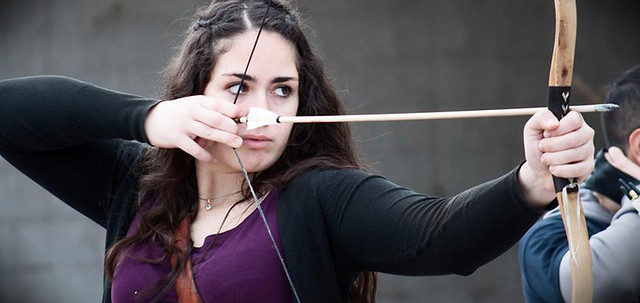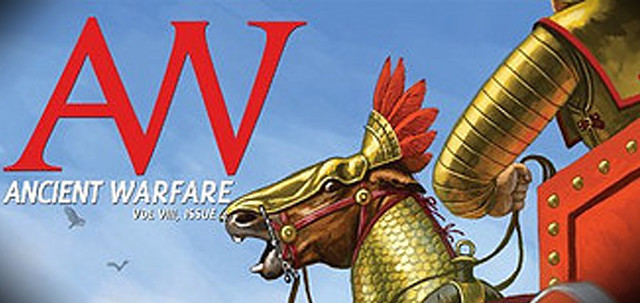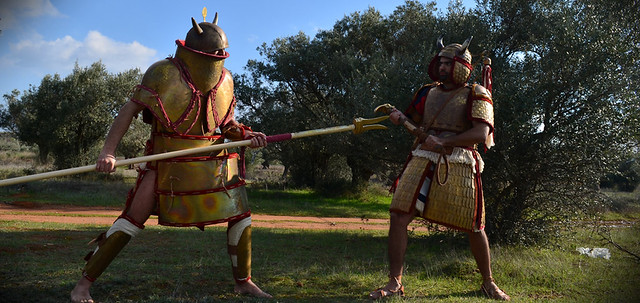Written by Spyros Bakas member of Association of Historical Studies "KORYVANTES" :
Evidence of composite bows usage in
Greece already exsists from
the early Mycenean period (1) as an evolutionary need to adapt to the way
war was requiring a bow with greater durability, power, accuracy and range from that of the simple wooden bow ( self bow) (2).
The inscription dated at the end of the 4th century BC from the city of Olbia (otherwise know as Borysthenis) gives us very interesting facts about the use of
the composite bow in the ancient Greek world, revisiting much of
what we know about the greatest features of this weapon
« ΦΗΜΙ
ΔΙΑΚΟΣΙΑΣ ΤΕ/ ΚΑΙ ΟΓΔΟΗΚΟΝΤΑ ΟΡΓΥΙΑΣ/ΚΑΙ ΔΥΟ ΤΟΞΕΥΣΑΙ/ ΚΛΕΙΝΟΝ ΑΝΑΞΑΓΟΡΑΝ/ΥΙΟΝ
ΔΗΜΑΓΟΡΕΩ/ΦΙΛΤΕΩ ΔΕ ΠΑΙΔΑ ΟΡΓΥΙΑΣ »(3)
 |
| Greek Archer from the classical period, with pelta, Thracian endromides, and Composite Scythian Bow taking a stationary shot.Note the pulling of the arrow from breast height, as depicted in contemporary pottery. Photo by Andreas Smaragdis. Recoconstruction: Association "KORYVANTES" |
This inscription is perhaps the first formal
record of a long
range archery contest in history. The inscription was found on the site of the
ancient Greek colony of Olvia Pontika, in today's Ukraine, and describes the
victorious shot of Anaxagoras’ son of Dimagoreos, who shot his arrow at a
distance of 282 orgyiae.
This distance according to attic measuring is identified as roughly 500
meters (4). Although the unit of measurement
of an orgyia had slight variations in other parts of the
Ancient Greek world, we believe that the Attic orgyia was used as the unit of
measurement, because Olbia was an Ionic Colony with close relations to Athens and Miletus (5) (6) .
The Scythian cultural,and especially martial influences (7) in the Greek colony was great. Evidence of this is the
fact that in this city appears a rare phenomenon where the coins were minted
in the form of arrowheads (8). Maybe
it is a unique case in the ancient Greek world, except for Crete, where a
strong culture of archery was so well developed. Moreover, shortly before the
event was recorded in the inscription, the famous battle of Thates River
(Kuban) took place during which the Scythian bow supporting the heavy infantry
managed to keep King Satyrus in power (9) .
 |
| Photo: Greek Archer from the classical period while attempting a long distance shot. Note the "Mediterranean method" of puling of the chord, performed with three fingers as depicted in various ancient Greek vases. Photo by Andreas Smaragdis. Reconstruction: Association "KORYVANTES" |
Anaxagoras could be either a Greek colonist
with at least one of his parents being of Greek origin or (most unlikely) he was a Hellenized Scythian. In each case, and
precisely because of the effect in the area of the dominant Scythian martial
methods, the bow used in this rare shot was probably the Scythian bow. We
can thus rule out other potential types of bows such as the Persian or
"Greek style bow " (10) (as it is generally known in international literature as the simple wooden bow). This holds true particularly for
the latter, due
to the inherent handicap of being made solely from wood, without the use of
other materials (11) .
This breaks the many stereotypes prominent today because of the range of the bows existing at that time. We are surprised to find evidence that negates all that we could imagine about the maximum ballistic abilities
of the ancient bows. The 500m range demonstrates that the ancient Scythian
composite bow was capable of unusually long distance shots. Let us suppose that a very “powerful” bow, (80 –100 lb) with a calibrated strong shaft arrow, light arrow point, small
short-cropped 3-inch feathers, but with a high trajectory angle could easily
cover long distances. It is then obvious that the power of the missile after such a long flight and added to the resistance of the air, could not be such as to make a lethal shot on the
intended target. This is in accordance with Procopius who describes the battle of Kallinicum in 531 AD, and wrote that the Persian arrow could not harm the Romans (Byzantines) as they had
over-passed their effective range (12).
 |
| Photo: Coin with the shape of an arrow from Pontic Olbia. 7-th -5th Century BC. source: http://www.museum.com.ua/ |
In each case the above mentioned inscription can be viewed as a "propaganda"
attempt to to exploit the fact. The public registration of such an achievement
may also had to do with underlining the superiority of the Infantry archer
against the Scythian or Sarmatian horsebackarcher. The residents of Olvia could now rely on the distant range of archers like Anaxagoras, who could neutralize the enemy on horseback long before the barbarians managed to harm them. This pattern of conflict between infantry and horseback
archers reminds us intensely of the
local superiority of the Athenian archers at the battle of Plataea during which
their long distance shots touched 350 meters repulsed the Persian Cavalry of Masistios (13).
 |
| Photo: the Hungarian Champion of flight shooting Monus Jozsef while taking aim during a Traditional Archery contest in Mongolia in 2012, in which he shot at 653 metres making a local record. |
Respective recordings of long-distance archery competitions (flight shooting ) appear later by other people. The so-called "column of Genghis Han" which is currently in the
Hermitaz Museum, records the event where the Mongol Prince Yisungka, won the long distance contest in 1224 AD by
shooting an arrow at almost 600 meters. In Ottoman times in
Istanbul there was an area named Ok Meydani, where
long-distance archery competitions took place and marble monuments were erected
to commemorate
the winners and record their results. Such marble monuments testify to famous shots
such as those of a
certain Iskender Toz Koparan in the year 1281 at 797 metres and Sultan Selim III at 889 metres (14). Finally, modern
experimental approaches of comparable shots, and also modern
archery competitions with traditional composite bows confirm that such
long-distances were technically possible for Anaxagoras during his time.
References:
(1) G. Steinhauer,War in ancient Greece,
Papadimas Publications, 2000, p38
2) Miller, McEwen,Bergman,
Experimental App!roaches to Ancient Near Eastern Archer!y, World Archaeology,
Vol 18, no2, Weaponry and Warfare,1986, pp180-182.
(3) Luigi Moretti, Inscrizioni
agonistiche greche (Rome 1953) 82-84, no 32
(4) Wallace McLeod,The Range of the
Ancient Bow.Phoenix,Vol.19, No1 (1965),p 6
(5), Henry A. Johnston, The
Earliest Colonisers of the Euxine Sea.: II. The Hellenisation of the Euxine,
Studies: An Irish Quarterly Review, Vol. 2, No.7 (Sep., 1913), pp 247-282
(6) M.Rostoftzeff , Iranians and
Greeks in South Russia, Oxford University Press 1922, pp165-174
(7) G. F. H., Greek Coins of the
Black Sea District, The British Museum Quarterly, Vol. 4, No. 3 (Dec., 1929), p
74
(8) Odessa Museum of Numismatics, http://www.museum.com.ua/expo/premonet_en.html,
as seen on May 26 2013
(9) E.V Cernenko,Angus McBride,M V
Gorelic, The Scythians 700-300 BC, Men At Arms Series, Osprey Publishing ,
1983, p31
(10) Beth
Cohen, From Bowman to Clubman : Heracles and Olympia.The Art Bulletin, Vol
76,No4, p 700
(11) 701H.Balfour. On the
Structure and Affinities of the Composite Bow. The Journal of anthropological
institute of Great Britain and Ireland. Vol 19.p 227
(12) T.L.G. Procopius
Historia, De Belis, 1.18.33
(13) T.L.G ,Herodotus
9.22-23
(14) Wallace
McLeod,The Range of the Ancient Bow.Phoenix,Vol.19, No1 (1965), pp
8-9






Δεν υπάρχουν σχόλια:
Δημοσίευση σχολίου